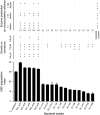Cellulose-degrading bacteria associated with the invasive woodwasp Sirex noctilio
- PMID: 21368904
- PMCID: PMC3146269
- DOI: 10.1038/ismej.2011.14
Cellulose-degrading bacteria associated with the invasive woodwasp Sirex noctilio
Abstract
Sirex noctilio is an invasive wood-feeding wasp that threatens the world's commercial and natural pine forests. Successful tree colonization by this insect is contingent on the decline of host defenses and the ability to utilize the woody substrate as a source of energy. We explored its potential association with bacterial symbionts that may assist in nutrient acquisition via plant biomass deconstruction using growth assays, culture-dependent and -independent analysis of bacterial frequency of association and whole-genome analysis. We identified Streptomyces and γ-Proteobacteria that were each associated with 94% and 88% of wasps, respectively. Streptomyces isolates grew on all three cellulose substrates tested and across a range of pH 5.6 to 9. On the basis of whole-genome sequencing, three Streptomyces isolates have some of the highest proportions of genes predicted to encode for carbohydrate-active enzymes (CAZyme) of sequenced Actinobacteria. γ-Proteobacteria isolates grew on a cellulose derivative and a structurally diverse substrate, ammonia fiber explosion-treated corn stover, but not on microcrystalline cellulose. Analysis of the genome of a Pantoea isolate detected genes putatively encoding for CAZymes, the majority predicted to be active on hemicellulose and more simple sugars. We propose that a consortium of microorganisms, including the described bacteria and the fungal symbiont Amylostereum areolatum, has complementary functions for degrading woody substrates and that such degradation may assist in nutrient acquisition by S. noctilio, thus contributing to its ability to be established in forested habitats worldwide.
Figures


Similar articles
-
Genome Sequencing and Analysis of the Fungal Symbiont of Sirex noctilio, Amylostereum areolatum: Revealing the Biology of Fungus-Insect Mutualism.mSphere. 2020 May 13;5(3):e00301-20. doi: 10.1128/mSphere.00301-20. mSphere. 2020. PMID: 32404513 Free PMC article.
-
Putative source of the invasive Sirex noctilio fungal symbiont, Amylostereum areolatum, in the eastern United States and its association with native siricid woodwasps.Mycol Res. 2009 Nov;113(Pt 11):1242-53. doi: 10.1016/j.mycres.2009.08.012. Epub 2009 Aug 27. Mycol Res. 2009. PMID: 19716415
-
Fidelity among Sirex woodwasps and their fungal symbionts.Microb Ecol. 2013 Apr;65(3):753-62. doi: 10.1007/s00248-013-0218-z. Epub 2013 Mar 27. Microb Ecol. 2013. PMID: 23532503 Free PMC article.
-
Sirex woodwasp: a model for evolving management paradigms of invasive forest pests.Annu Rev Entomol. 2015 Jan 7;60:601-19. doi: 10.1146/annurev-ento-010814-021118. Epub 2014 Oct 24. Annu Rev Entomol. 2015. PMID: 25386723 Review.
-
Context-dependent interactions of insects and defensive symbionts: insights from a novel system in siricid woodwasps.Curr Opin Insect Sci. 2019 Jun;33:77-83. doi: 10.1016/j.cois.2019.03.006. Epub 2019 Apr 3. Curr Opin Insect Sci. 2019. PMID: 31358200 Review.
Cited by
-
Microbiota and functional analyses of nitrogen-fixing bacteria in root-knot nematode parasitism of plants.Microbiome. 2023 Mar 10;11(1):48. doi: 10.1186/s40168-023-01484-3. Microbiome. 2023. PMID: 36895023 Free PMC article.
-
Characterization of Cellulose-Degrading Bacteria Isolated from Silkworm Excrement and Optimization of Its Cellulase Production.Polymers (Basel). 2023 Oct 19;15(20):4142. doi: 10.3390/polym15204142. Polymers (Basel). 2023. PMID: 37896386 Free PMC article.
-
Micromonospora from nitrogen fixing nodules of alfalfa (Medicago sativa L.). A new promising Plant Probiotic Bacteria.Sci Rep. 2014 Sep 17;4:6389. doi: 10.1038/srep06389. Sci Rep. 2014. PMID: 25227415 Free PMC article.
-
Colonization of the Intestinal Tract of the Polyphagous Pest Spodoptera littoralis with the GFP-Tagged Indigenous Gut Bacterium Enterococcus mundtii.Front Microbiol. 2016 Jun 14;7:928. doi: 10.3389/fmicb.2016.00928. eCollection 2016. Front Microbiol. 2016. PMID: 27379058 Free PMC article.
-
Development and characterization of stable anaerobic thermophilic methanogenic microbiomes fermenting switchgrass at decreasing residence times.Biotechnol Biofuels. 2018 Sep 6;11:243. doi: 10.1186/s13068-018-1238-1. eCollection 2018. Biotechnol Biofuels. 2018. PMID: 30202438 Free PMC article.
References
-
- Adams AS, Adams SM, Currie CR, Gillette NE, Raffa KF. Geographic variation in bacterial communities associated with the red turpentine beetle (Coleoptera: Curculionidae) Environ Entomol. 2010;39:406–414. - PubMed
-
- Balogun RA. Digestive enzymes of the alimentary canal of the larch bark beetle Ips cembrae Heer. Comp Biochem Physiol. 1969;29:1267–1270.
-
- Bennett S. Solexa Ltd. Pharmacogenomics. 2004;5:433–438. - PubMed
-
- Bentz BJ, Six DL. Ergosterol content of three fungal species associated with Dendroctonus ponderosae and D. rufipennis (Coleoptera: Curculionidae, Scolytinae) Ann Entomol Soc Am. 2006;99:189–194.
Publication types
MeSH terms
Substances
LinkOut - more resources
Full Text Sources
Other Literature Sources

